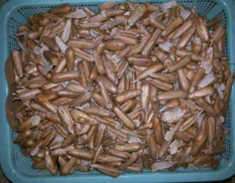
Back Pandanus julianettii CEB കരുക Malayalam Pandanus julianettii Polish Pandanus julianettii Swedish Karuka Vietnamese Pandanus julianettii WAR
| Karuka | |
|---|---|

| |
| Pandanus julianettii fruit cluster | |
| Scientific classification | |
| Kingdom: | Plantae |
| Clade: | Tracheophytes |
| Clade: | Angiosperms |
| Clade: | Monocots |
| Order: | Pandanales |
| Family: | Pandanaceae |
| Genus: | Pandanus |
| Subgenus: | Pandanus subg. Lophostigma |
| Section: | Pandanus sect. Karuka |
| Species: | P. julianettii
|
| Binomial name | |
| Pandanus julianettii | |
| Synonyms | |
 | |||||||||||||||||||||||||||||
| Nutritional value per 100 g | |||||||||||||||||||||||||||||
|---|---|---|---|---|---|---|---|---|---|---|---|---|---|---|---|---|---|---|---|---|---|---|---|---|---|---|---|---|---|
| Energy | 2,259–2,929 kJ (540–700 kcal) | ||||||||||||||||||||||||||||
28-33.5 g | |||||||||||||||||||||||||||||
| Sugars | 5 g | ||||||||||||||||||||||||||||
| Dietary fiber | 9.2-25 g | ||||||||||||||||||||||||||||
35.6-47 g | |||||||||||||||||||||||||||||
| Saturated | 18 g | ||||||||||||||||||||||||||||
| Trans | 0 | ||||||||||||||||||||||||||||
11.9-18 g | |||||||||||||||||||||||||||||
| Tryptophan | 102-136 mg | ||||||||||||||||||||||||||||
| Threonine | 435-482 mg | ||||||||||||||||||||||||||||
| Isoleucine | 503-555 mg | ||||||||||||||||||||||||||||
| Leucine | 904-993 mg | ||||||||||||||||||||||||||||
| Lysine | 426-526 mg | ||||||||||||||||||||||||||||
| Methionine | 272-279 mg | ||||||||||||||||||||||||||||
| Cystine | 204-234 mg | ||||||||||||||||||||||||||||
| Phenylalanine | 571-613 mg | ||||||||||||||||||||||||||||
| Tyrosine | 408-438 mg | ||||||||||||||||||||||||||||
| Valine | 745-832 mg | ||||||||||||||||||||||||||||
| Arginine | 1238-1329 mg | ||||||||||||||||||||||||||||
| Histidine | 293-336 mg | ||||||||||||||||||||||||||||
| Alanine | 585-642 mg | ||||||||||||||||||||||||||||
| Aspartic acid | 1064-1197 mg | ||||||||||||||||||||||||||||
| Glutamic acid | 2285-2453 mg | ||||||||||||||||||||||||||||
| Glycine | 638-701 mg | ||||||||||||||||||||||||||||
| Proline | 530-613 mg | ||||||||||||||||||||||||||||
| Serine | 545-584 mg | ||||||||||||||||||||||||||||
| |||||||||||||||||||||||||||||
| Other constituents | Quantity | ||||||||||||||||||||||||||||
| Water | 9% | ||||||||||||||||||||||||||||
| Cholesterol | 0 | ||||||||||||||||||||||||||||
| †Percentages estimated using US recommendations for adults,[4] except for potassium, which is estimated based on expert recommendation from the National Academies.[5] Source: [3][2] | |||||||||||||||||||||||||||||
| Nutritional value per 100 g | |||||||||||||
|---|---|---|---|---|---|---|---|---|---|---|---|---|---|
| Dietary fiber | 5.3 g | ||||||||||||
0.43 g | |||||||||||||
8.5 g | |||||||||||||
| Threonine | 289 mg | ||||||||||||
| Isoleucine | 281 mg | ||||||||||||
| Leucine | 485 mg | ||||||||||||
| Lysine | 196 mg | ||||||||||||
| Methionine | 170 mg | ||||||||||||
| Phenylalanine | 315 mg | ||||||||||||
| Tyrosine | 323 mg | ||||||||||||
| Valine | 340 mg | ||||||||||||
| Arginine | 255 mg | ||||||||||||
| Histidine | 162 mg | ||||||||||||
| Alanine | 391 mg | ||||||||||||
| Aspartic acid | 672 mg | ||||||||||||
| Glutamic acid | 748 mg | ||||||||||||
| Glycine | 459 mg | ||||||||||||
| Proline | 196 mg | ||||||||||||
| Serine | 315 mg | ||||||||||||
| |||||||||||||
| Other constituents | Quantity | ||||||||||||
| Cholesterol | 0 | ||||||||||||
| †Percentages estimated using US recommendations for adults,[4] except for potassium, which is estimated based on expert recommendation from the National Academies.[5] Source: [3][2] | |||||||||||||
The karuka (Pandanus julianettii, also called karuka nut and Pandanus nut) is a species of tree in the screwpine family (Pandanaceae) and an important regional food crop in New Guinea.[6] The nuts are more nutritious than coconuts,[2] and are so popular that villagers in the highlands will move their entire households closer to trees for the harvest season.[7][8]
- ^ a b Martelli, Ugolino (December 1907). Martelli, Ugolino (ed.). "Pandanus Nuove Specie Descritte Manipolo II". Webbia, Raccolta di Scritti Botanici (in Italian). 2: 433. doi:10.1080/00837792.1907.10803460. hdl:2027/mdp.39015038487925. ISSN 2169-4060. OCLC 899525984. Archived from the original on 2022-08-12. Retrieved 2022-09-26.
- ^ a b c d Cite error: The named reference
Rose82was invoked but never defined (see the help page). - ^ a b French, Bruce R. (1982). Growing food in the Southern Highlands Province of Papua New Guinea (PDF). AFTSEMU (Agricultural Field Trials, Surveys, Evaluation and Monitoring Unit) of the World Bank funded project in the Southern Highlands of Papua New Guinea. pp. 64–71. Archived from the original on 30 October 2018. Retrieved 20 September 2018.
- ^ a b United States Food and Drug Administration (2024). "Daily Value on the Nutrition and Supplement Facts Labels". FDA. Archived from the original on 2024-03-27. Retrieved 2024-03-28.
- ^ a b National Academies of Sciences, Engineering, and Medicine; Health and Medicine Division; Food and Nutrition Board; Committee to Review the Dietary Reference Intakes for Sodium and Potassium (2019). Oria, Maria; Harrison, Meghan; Stallings, Virginia A. (eds.). Dietary Reference Intakes for Sodium and Potassium. The National Academies Collection: Reports funded by National Institutes of Health. Washington, DC: National Academies Press (US). ISBN 978-0-309-48834-1. PMID 30844154. Archived from the original on 2024-05-09. Retrieved 2024-06-21.
- ^ Lim, Tong Kwee (2012). "Pandanus julianettii". Edible Medicinal and Non-Medicinal Plants. Vol. 4. Springer. pp. 128–130. doi:10.1007/978-94-007-4053-2_17. ISBN 978-94-007-4053-2. OCLC 822591349.
- ^ Bourke, Richard Michael (1994). "Edible indigenous nuts in Papua New Guinea" (PDF). In Stevens, M.L.; Bourke, Richard Michael; Evans, Barry R. (eds.). South Pacific Indigenous Nuts. Proceedings of a workshop held from 31 October to 4 November 1994 at Le Lagon Resort, Port Vila, Vanuatu. Australian Centre for International Agricultural Research Proceedings. Vol. 69. Canberra: Australian Centre for International Agricultural Research. pp. 45–55. ISBN 1-86320-485-7. OCLC 38390455. Retrieved 27 September 2018.
- ^ Cite error: The named reference
Bourke88was invoked but never defined (see the help page).